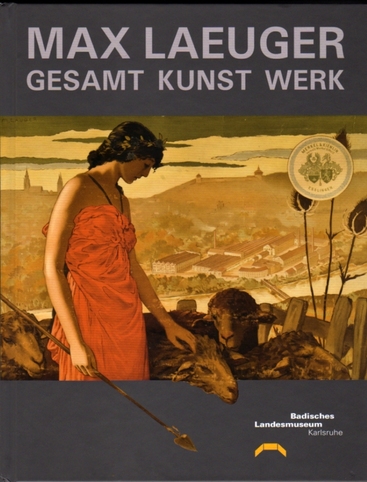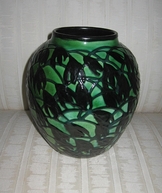
Max Laeuger: Gesamt Kunst Werk is the catalogue for the recently opened exhibition in Baden-Wurtemburg, Germany, that addresses ‘all’ the artwork of Max Laeuger, architecture, interior design, watercolours, sculpture, and ceramics. On the cover the editor has placed one of Laeuger’s earliest works, an advertising poster he produced for a woolen manufacturer in 1894. Here the young Laeuger’s portrayal of wool from Classical sheep to modern mill has inadvertently also symbolized the aesthetic poles of his own career: in the foreground an Art Nouveau idealization of the pastoral; in the background the geometric factory buildings which would not only serve two World Wars but help inspire Constructivism, the Bauhaus, Futurism and Cubism, as well as the functional architecture of concentration camps. It’s an appropriate cover for a book that portrays Laeuger, in the words of the concluding essay, as “an artist between the epochs, a pedagogue in contradiction” (283).
I first noticed Max Laueger’s artwork only a few years ago when I encountered an unusual vase (below, left) at a London, Ontario, estate auction. It was 9" high and 9" across its waist, mid-green with a unusually regular, almost geometric, network of black shapes in an overlaid glaze all around it. It was too geometric and abstract to be Art Nouveau but perhaps not sufficiently to be Art Deco. The auction house knew it was a Laeuger, and I further tracked it to his Kandern workshop, in the state of Baden-Württemberg in southwestern Germany, around 1908. So it was contemporary with the painters of Die Brücke and Der Blaue Reiter, and with the early canvasses of Picasso and the Delaunays. That seemed to make sense. I soon discovered that Laeuger had been born in 1864 during the German equivalent of the Victorian period, produced his first works in 1884-1900 while the Pre-Raphaelites, Art Nouveau and, in Germany, Jugendstil were flourishing, and then had become a respected contemporary of successive waves of modernism including German Expressionism and the Bauhaus, with numerous international exhibitions including a gold medal at the Paris Exhibition in 1925.

 RSS Feed
RSS Feed